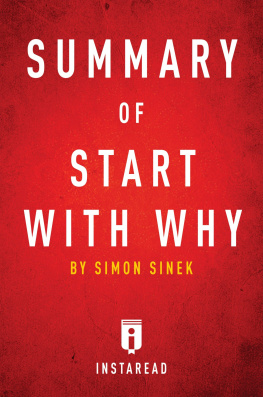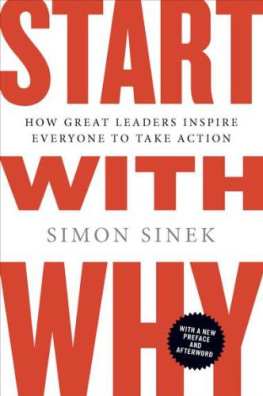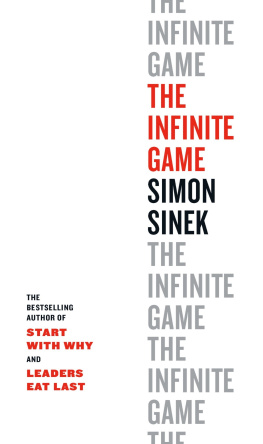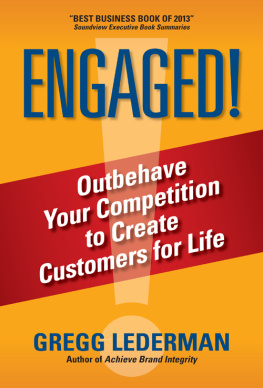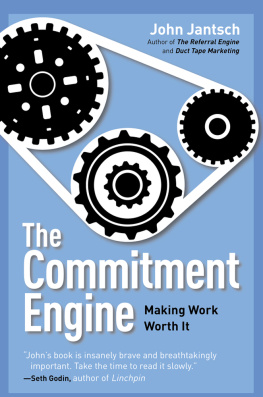Summary of
Start With Why
How Great Leaders Inspire Everyone to Take Action
by Simon Sinek

Instaread

Please Note
This is a summary with analysis.
Copyright 2016 by Instaread. All rights reserved worldwide. No part of this publication may be reproduced or transmitted in any form without the prior written consent of the publisher.
Limit of Liability/Disclaimer of Warranty: The publisher and author make no representations or warranties with respect to the accuracy or completeness of these contents and disclaim all warranties such as warranties of fitness for a particular purpose. The author or publisher is not liable for any damages whatsoever. The fact that an individual or organization is referred to in this document as a citation or source of information does not imply that the author or publisher endorses the information that the individual or organization provided. This concise summary is unofficial and is not authorized, approved, licensed, or endorsed by the original books author or publisher.
Table of Contents
Overview
Start With Why by Simon Sinek is a self-help book for business leaders seeking ways of gaining authenticity through a focus on their purpose.
Most companies rely on manipulations to attract customers and employees; they use short-term motivators that do not inspire or encourage loyalty. Customers who are not inspired will stop buying the product as soon as the company cannot keep up the manipulative strategies, and employees are less motivated and less productive when they are not inspired.
Instead of strategies based on keeping up with competitors and metrics meant to determine the companys basic productivity, companies should form strategies that advance its purpose, or its why, and find metrics that measure how the company advances that why. Only with a firm idea of why the company does its work and how it intends to fulfill that purpose can employees then decide what to do at work. Customers will gravitate toward brands that align with their own purposes, and they will pay a premium in time or cost to buy those products.
Leadership that affirms a companys why relies on trust and the cultivation of a culture that ensures that the leaders message is amplified by every employee. This requires a company to forego strategies that seek all possible customers and instead focus on attracting loyal early adopters. It is common for companies to have one inspiring leader who embodies the companys why and an energetic leader who can make the plans for the companys how. The company culture requires consistency through its symbols, such as logos, as well as its strategies.
When a visionary leader leaves, companies tend to lose sight of the focus on why and instead focus on shareholder demands or competitive indicators. This loss of focus can also occur at lower levels of the organization as a company becomes large and successful. These lapses can be avoided with consistent metrics, an emphasis on company culture, and a succession plan that perpetuates the leaders vision. Above all, finding and maintaining a companys purpose requires reflection and a struggle to find focus through trial and error.
Start With Why was first published in 2009.
Important People
Simon Sinek is a consultant and public speaker who is an adjunct staff member at the Rand Corporation, where he focuses on military innovation.
Ernest Shackleton (1874-1922) was a British explorer who led pioneering expeditions across the Antarctic.
Wilbur and Orville Wright (1867-1912 and 1871-1948) were inventors who are credited with the first piloted airplane flight.
John Fitzgerald Kennedy (1917-1963) was the 35th president of the United States, known for setting the goal of putting an American astronaut on the moon before 1970.
Martin Luther King Jr. (1929-1968) was a civil rights leader who led marches and boycotts to advocate for racial equality.
Steve Jobs (1955-2011) was the co-founder and chief executive officer of Apple, Inc.
Herb Kelleher is the former CEO of Southwest Airlines.
Gordon Bethune is the former CEO of Continental Airlines. He is widely recognized for rescuing the airlines reputation.
Key Takeaways
- Current assumptions about business success encourage leaders to focus on competition and manipulating customers to buy, despite evidence that these strategies are ineffective and costly.
- The best business strategies start with a focus on why the company exists, then on how the company will fulfill that purpose, and lastly on what operations will complete that plan.
- Customers are attracted to companies whose purposes align with their own because they want to feel a sense of belonging. Those customers will be loyal when a company cannot afford to offer the same low prices or easy access as its competitors.
- Companies with a focus on their purpose encourage true innovation above and beyond market competition.
- Statements of why the company exists and how it fulfills that purpose appeal to the limbic brain, which governs emotions. The limbic brain is easier to convince than the neocortex, which recognizes statements of what the company does.
- Leading a company with a strong sense of purpose involves growing trust, cultivating a purposeful culture, and seeking employees with a strong sense of purpose who respond well to challenges.
- Companies are better off building strong relationships with early adopters and courting their loyalty, as opposed to pursuing all potential customers and accepting a low rate of loyalty.
- Successful companies often have one visionary leader who focuses on why and a planning leader who establishes how. The rest of the organization amplifies the why and how in what it does.
- Purpose can be established through consistency in message from leadership, in strategy and practices, and in symbols such as logos.
- When a visionary leader leaves a company, or when it grows larger, that company can lose its focus on purpose.
- Ensuring focus on purpose throughout a companys lifetime requires a strong culture and a plan of succession that ensures future leaders maintain the same message.
- Companies with a strong focus on why engage in reflection, learn lessons from failure, and only compete against themselves.

We hope you are enjoying this Instaread ebook
Download the Instaread mobile app to get unlimited text & audio summaries of bestselling books.
CLICK HERE TO LEARN MORE
Analysis
Key Takeaway 1
Current assumptions about business success encourage leaders to focus on competition and manipulating customers to buy, despite evidence that these strategies are ineffective and costly.
Analysis
Companies routinely use manipulation to attract customers through pricing, promotions, fear of missed opportunities, desire to emulate others, peer pressure, or novelty. A leading company relies on inspiration and true innovation to attract loyal customers and employees, but most companies are content to use strategies that attract customers in the short term and which are separated from the companys purpose.
A company that exhibited its disinterest in a greater purpose for its product is the manufacturer of EpiPen, a medical device that injects epinephrine to treat an immediate and severe allergic reaction. In August 2016, EpiPen manufacturer Mylan NV was criticized vehemently for raising the wholesale price of its devices from under $50 in 2007 to more than $280 in summer 2016. Because no one else produces EpiPens, the manufacturer could raise prices without concerns about competition. After US politicians urged Mylan to lower those prices, the manufacturer agreed to give coupons for discounts to users whose insurance does not cover the entire cost. However, as with any other coupon program, this plan ensures some customers will pay full price for their purchases because they fail to complete the steps to get a discount or because they dont want to deal with the hassle. [1] If Mylan considered its purpose to be preventing people with life-threatening allergies from dying, raising prices to a point where most current users could not afford to buy the drug would be in opposition to that purpose. Such a move exposes the company as profit-driven rather than purpose-driven, which in turn jeopardizes consumers trust and loyalty.
Next page
